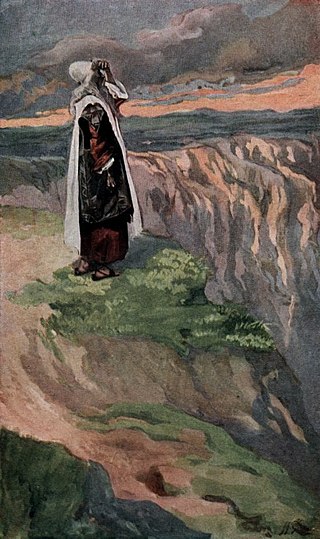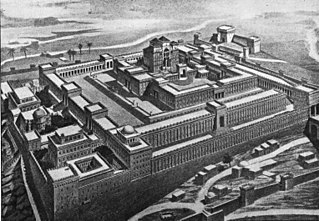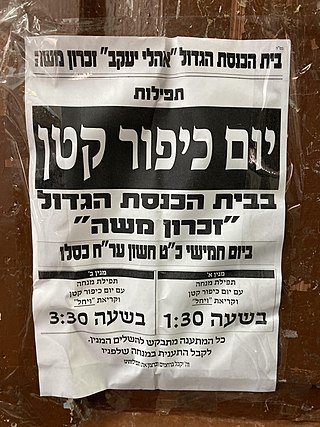Related Research Articles

Jewish holidays, also known as Jewish festivals or Yamim Tovim, are holidays observed by Jews throughout the Hebrew calendar. They include religious, cultural and national elements, derived from three sources: mitzvot, rabbinic mandates, the history of Judaism, and the State of Israel.

Sukkot, also known as the Feast of Tabernacles or Feast of Booths, is a Torah-commanded holiday celebrated for seven days, beginning on the 15th day of the month of Tishrei. It is one of the Three Pilgrimage Festivals on which Israelites were commanded to make a pilgrimage to the Temple in Jerusalem. Biblically an autumn harvest festival and a commemoration of the Exodus from Egypt, Sukkot’s modern observance is characterized by festive meals in a sukkah, a temporary wood-covered hut.
Shemini Atzeret is a Jewish holiday. It is celebrated on the 22nd day of the Hebrew month of Tishrei, usually coinciding with late September or early October. It directly follows the festival of Sukkot, which is celebrated for seven days; thus, Shemini Atzeret is literally the eighth day [of assembly]. It is a separate—yet connected—holy day devoted to the spiritual aspects of the festival of Sukkot. Part of its duality as a holy day is that it is simultaneously considered to be connected to Sukkot and a separate festival in its own right.

The haftara or haftorah "parting," "taking leave", is a series of selections from the books of Nevi'im ("Prophets") of the Hebrew Bible (Tanakh) that is publicly read in synagogue as part of Jewish religious practice. The haftara reading follows the Torah reading on each Sabbath and on Jewish festivals and fast days. Typically, the haftara is thematically linked to the parashah that precedes it. The haftara is sung in a chant. Related blessings precede and follow the haftara reading.

In Judaism, Rosh Chodesh or Rosh Hodesh is a minor holiday observed at the beginning of every month in the Hebrew calendar, marked by the birth of a new moon. Rosh Chodesh is observed for either one or two days, depending on whether the previous month contained 29 or 30 days.
In Judaism, the korban, also spelled qorban or corban, is any of a variety of sacrificial offerings described and commanded in the Torah. The plural form is korbanot, korbanoth, or korbanos.
Torah reading is a Jewish religious tradition that involves the public reading of a set of passages from a Torah scroll. The term often refers to the entire ceremony of removing the scroll from the Torah ark, chanting the appropriate excerpt with special cantillation (trope), and returning the scroll(s) to the ark. It is also commonly called "laining".
Maftir is the last person called up to the Torah on Shabbat and holiday mornings: this person also reads the haftarah portion from a related section of the Nevi'im.

Mishpatim is the eighteenth weekly Torah portion in the annual Jewish cycle of Torah reading and the sixth in the Book of Exodus. The parashah sets out a series of laws, which some scholars call the Covenant Code. It reports the people's acceptance of the covenant with God. The parashah constitutes Exodus 21:1–24:18. The parashah is made up of 5,313 Hebrew letters, 1,462 Hebrew words, 118 verses, and 185 lines in a Torah scroll.

Ki Tisa, Ki Tissa, Ki Thissa, or Ki Sisa is the 21st weekly Torah portion (parashah) in the annual Jewish cycle of Torah reading and the ninth in the Book of Exodus. The parashah tells of building the Tabernacle, the incident of the Golden calf, the request of Moses for God to reveal God's Attributes, and how Moses became radiant.
Chol HaMoed, a Hebrew phrase meaning "mundane of the festival", refers to the intermediate days of Passover and Sukkot. As the name implies, these days mix features of chol (mundane) and moed (festival).

Emor is the 31st weekly Torah portion in the annual Jewish cycle of Torah reading and the eighth in the Book of Leviticus. The parashah describes purity rules for priests, recounts the holy days, describes the preparations for the lights and bread in the sanctuary, and tells the story of a blasphemer and his punishment. The parashah constitutes Leviticus 21:1–24:23. It has the most verses of any of the weekly Torah portions in the Book of Leviticus, and is made up of 6,106 Hebrew letters, 1,614 Hebrew words, 124 verses and 215 lines in a Torah Scroll.

Pinechas, Pinchas, Pinhas, or Pin'has is the 41st weekly Torah portion in the annual Jewish cycle of Torah reading and the eighth in the Book of Numbers. It tells of Phinehas's killing of a couple, ending a plague, and of the daughters of Zelophehad's successful plea for land rights. It constitutes Numbers 25:10–30:1. The parashah is made up of 7,853 Hebrew letters, 1887 Hebrew words, 168 verses, and 280 lines in a Torah scroll.

Re'eh, Reeh, R'eih, or Ree is the 47th weekly Torah portion in the annual Jewish cycle of Torah reading and the fourth in the Book of Deuteronomy. It comprises Deuteronomy 11:26–16:17. In the parashah, Moses set before the Israelites the choice between blessings and curses. Moses instructed the Israelites in laws that they were to observe, including the law of a single centralized place of worship. Moses warned against following other gods and their prophets and set forth the laws of kashrut, tithes, the Sabbatical year, the Hebrew slave redemption, firstborn animals, and the Three Pilgrimage Festivals.
Special Shabbatot are Jewish Shabbat days on which special events are commemorated. Variations in the liturgy and special customs differentiate them from the other Shabbats and each one is referred to by a special name. Many communities also add piyyutim on many of these special Shabbatot. Two such Shabbats, Shabbat Mevarchim—the Shabbat preceding a new Hebrew month—and Shabbat Rosh Chodesh can occur on several occasions throughout the year. The other special Shabbats occur on specific sabbaths before or coinciding with certain Jewish holidays during the year according to a fixed pattern.
The modern Hebrew calendar has been designed to ensure that certain holy days and festivals do not fall on certain days of the week. As a result, there are only four possible patterns of days on which festivals can fall.
Nusach Ashkenaz is a style of Jewish liturgy conducted by Ashkenazi Jews. It is primarily a way to order and include prayers, and differs from Nusach Sefard and Baladi-rite prayer, and still more from the Sephardic rite proper, in the placement and presence of certain prayers.

Yom Kippur Katan, is a practice observed by some Jews on the day preceding each Rosh Chodesh. The observance consists of fasting and supplication, but is much less rigorous than that of Yom Kippur proper.
Shevi'i shel Pesach is the seventh and last day of the Passover holiday, which falls on the 21st of Nisan. On this day, according to the jewish tradition the splitting of the Red Sea occurred. Beyond the commandments that exist on each of the seven days of Passover, this is a full holiday, in which work is forbidden, except for work related to preparing food.
References
- ↑ The Complete Artscroll Siddur, page 954
- ↑ "Torah Readings - Study & History - Passover". Chabad. Retrieved 2011-03-28.
- 1 2 Mangel, Rabbi Nisson (2007). Siddur Tehillat Hashem. Brooklyn: Merkos L'Inyonei Chinuch. pp. 496–498. ISBN 978-0-8266-0153-7.
- ↑ Mangel, Rabbi Nisson (2007). Siddur Tehillat Hashem. Brooklyn: Merkos L'Inyonei Chinuch. pp. 498–501. ISBN 978-0-8266-0153-7.
- 1 2 3 4 5 6 7 "Passover Torah Readings - Festivals & Special Readings - Parsha". Chabad. Retrieved 2011-03-28.
- ↑ Mangel, Rabbi Nisson (2007). Siddur Tehillat Hashem. Brooklyn: Merkos L'Inyonei Chinuch. p. 502. ISBN 978-0-8266-0153-7.
- ↑ Mangel, Rabbi Nisson (2007). Siddur Tehillat Hashem. Brooklyn: Merkos L'Inyonei Chinuch. p. 503. ISBN 978-0-8266-0153-7.
- ↑ Mangel, Rabbi Nisson (2007). Siddur Tehillat Hashem. Brooklyn: Merkos L'Inyonei Chinuch. p. 504. ISBN 978-0-8266-0153-7.
- ↑ Mangel, Rabbi Nisson (2007). Siddur Tehillat Hashem. Brooklyn: Merkos L'Inyonei Chinuch. p. 505. ISBN 978-0-8266-0153-7.
- ↑ Mangel, Rabbi Nisson (2007). Siddur Tehillat Hashem. Brooklyn: Merkos L'Inyonei Chinuch. pp. 506–509. ISBN 978-0-8266-0153-7.
- ↑ The Complete Artscroll Siddur, page 962
- 1 2 3 4 Mangel, Rabbi Nisson (2007). Siddur Tehillat Hashem. Brooklyn: Merkos L'Inyonei Chinuch. pp. 509–513. ISBN 978-0-8266-0153-7.
- 1 2 Mangel, Rabbi Nisson (2007). Siddur Tehillat Hashem. Brooklyn: Merkos L'Inyonei Chinuch. pp. 513–517. ISBN 978-0-8266-0153-7.
- ↑ In the Italian rite, they begin with Deuteronomy 15:12, see Machzor Shadal Volume 1, page 128a
- ↑ The Complete Artscroll Siddur, page 966
- ↑ Mangel, Rabbi Nissen (2007). Siddur Tehillat Hashem. Brooklyn: Merkos L'Inyonei Chinuch. pp. 520–523. ISBN 978-0-8266-0153-7.
- 1 2 Mangel, Rabbi Nissen (2007). Siddur Tehillat Hashem. Brooklyn: Merkos L'Inyonei Chinuch. pp. 523–527. ISBN 978-0-8266-0153-7.
- ↑ In the Italian rite, they begin with Deuteronomy 15:12, see Machzor Shadal Volume 1, page 128a
- ↑ It does not appear in the Western Ashkenazic Rödelheim machzorim, and despite being mentioned by the Maharil, it is not recited in any modern Western Ashkenazic communities.
- 1 2 The Complete Artscroll Siddur, page 969
- ↑ Isaac Neuman; Michael Palencia-Roth (1990). The narrow bridge: beyond the Holocaust. University of Illinois Press. p. 90. ISBN 9780252025617 . Retrieved 2011-03-28– via Google Books.
- ↑ Macy Nulman, The Encyclopedia of Jewish Prayer (1993, NJ: Jason Aronson) s.v. "Yetziv Pitgam" page 375.
- ↑ Philip Birnbaum, Prayer Book for the Three Festivals (1971, NY, Hebrew Publ'g Co.) page 309.
- ↑ The Complete Artscroll Siddur, page 969, which translates the last verse literally as "To Yehonasan, the epitome of humility, let us extend gracious praise"—but the same publisher and apparently the same translators and editors, in The Complete ArtScroll Machzor: Shavuos (1995) page 529—and Philip Birnbaum, Prayer Book for the Three Festivals (1971, New York, Hebrew Publishing Co.) page 310, and Emanuel Green, Service of the Synagogue: Pentecost (1928, New York, Hebrew Publishing Co.) page 204–evidently squeeze the familiar name for its etymological meaning, namely "God has given", and so translate this line, "God gave [the tablets] to the meekest of men [namely Moses], so let us ...".
- ↑ Yona Fraenkel, Machzor for Passover, Jerusalem 1993, page 20-21 in the introduction.
- ↑ The Complete Artscroll Siddur, page 956
- ↑ Mangel, Rabbi Nissen (2007). Siddur Tehillat Hashem. Brooklyn: Merkos L'Inyonei Chinuch. pp. 471–4480. ISBN 978-0-8266-0153-7.
- ↑ De Sola Pool, Rabbi David (1960). The Traditional Prayer Book for Sabbath and Festivals. New York: Behrman House. pp. 811–814.
- ↑ Mahzor Hazon Ovadia and other Sephardic machzorim. See also Daniel Goldschmidt and Yonah Fraenkel, Machzor for Sukkot, page 17 of introduction.
- ↑ The Complete Artscroll Siddur, pages 964–974
- ↑ Goldschmidt Sukkot Machzor, page 23 of introduction.
- ↑ See Machzor Shadal Volume 2, page 186a.
- 1 2 Hillel Sermanita and Angelo Piattelli, Sukkot Machzor according to the Italian custom as practiced in Jerusalem, Jerusalem 2024, pages 140-141.
- ↑ The Complete Artscroll Siddur, page 960
- 1 2 Irving Greenberg (2011). The Jewish way: living the holidays. Simon and Schuster. p. 213. ISBN 9781451644272 . Retrieved 2011-03-28– via Google Books.
- 1 2 3 4 5 Scherman, Rabbi Nosson (1985). The Complete Artscroll Machzor Rosh Hashanah. Brooklyn: Mesorah Publications. pp. 402–424. ISBN 0899066763.
- ↑ The Torah Reader's Compendium (The Kestenbaum ed.). Mesorah Publications. 2001. pp. 672–675. ISBN 1-57819-313-3.
- ↑ Machzor Shadal, Volume 2, page 117a; this was also the practice in the Romaniote rite.
- 1 2 Scherman, Rabbi Nosson (1985). The Complete Artscroll Machzor Yom Kippur. Brooklyn: Mesorah Publications. pp. 452–464. ISBN 0899066763.
- ↑ Scherman, Rabbi Nosson (1985). The Complete Artscroll Machzor Yom Kippur. Brooklyn: Mesorah Publications. pp. 630–647. ISBN 0-89906-676-3.
- 1 2 "Yom Kippur". Hebcal. Retrieved 11 September 2014.
- ↑ Machzor Shadal, Volume 2, page 137b.
- ↑ Mangel, Rabbi Nissen (2007). Siddur Tehillat Hashem. Brooklyn: Merkos L'Inyonei Chinuch. p. 468. ISBN 978-0-8266-0153-7.
- ↑ However, the practice in most Ashkenazic communities in Jerusalem, based on the practice of the Vilna Gaon is to read 28:4-8 for the second reading and to repeat in the next reading. See Siddur Ezor Eliyahu page 511.
- ↑ "Shabbat Rosh Chodesh". Hebcal.
- ↑ "Shabbat Machar Chodesh". Hebcal.
- ↑ Mangel, Rabbi Nissen (2007). Siddur Tehillat Hashem. Brooklyn: Merkos L'Inyonei Chinuch. pp. 490–495. ISBN 978-0-8266-0153-7.
- ↑ However, some begin the reading with Numbers 6:22.
- ↑ This variant appears in Rodelheim siddurim, and it is observed in most German communities.
- ↑ "Chanukah- The Procedure for Torah Reading When Rosh Chodesh Tevet Falls on Shabbat". DailyHalacha. 2010.
- ↑ However, according to the custom of Frankfurt, the reading concludes with Numbers 7:89.
- ↑ However, according to the custom of Frankfurt, the reading concludes with Number 7:89.
- ↑ See the different customs in Shulchan Aruch OC 684:1.
- ↑ However, some begin the reading with .
- ↑ "Chanukah- The Procedure for Torah Reading When Rosh Chodesh Tevet Falls on Shabbat". DailyHalacha. 2010.
- ↑ Mangel, Rabbi Nissen (2007). Siddur Tehillat Hashem. Brooklyn: Merkos L'Inyonei Chinuch. pp. 495–496. ISBN 978-0-8266-0153-7.
- ↑ See Shulchan Aruch OC 693:4.
- ↑ "Shacharit for Tisha b'Av".[ dead link ]
- 1 2 "wikisource".[ dead link ]
- ↑ Levush.